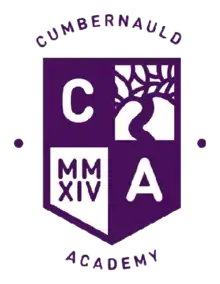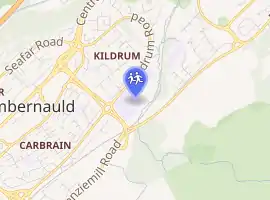Cumbernauld Academy
[This page used to refer to Cumbernauld High School. It now refers to the replacement school, Cumbernauld Academy but contains little information about this school. It needs to be largely rewritten and if it is to be about both schools, needs to maintain the historical links and information that were contained within. Much of this historical data has been removed]
| Cumbernauld Academy | |
|---|---|
 | |
| Address | |

| |
South Kildrum Ring Road , , G67 2UF Scotland | |
| Coordinates | 55°56′54″N 3°58′09″W |
| Information | |
| Type | Secondary school |
| Motto | Virtute Ac Labore (Latin: 'Virtue through Hard Work') |
| Established | 2014 |
| Status | Open |
| Local authority | North Lanarkshire |
| Head Teacher | Mr Cairns |
| Staff | 60.2 FTE |
| Gender | Coeducational |
| Age | 11 to 18 |
| Enrolment | c 820[1] |
| Houses | Islay Arran Skye |
| Colour(s) | Black, Purple, white |
| Website | https://blogs.glowscotland.org.uk/nl/CAcad/ |
Overview
Cumbernauld Academy is a non denominational, secondary school in Cumbernauld. It replaced Cumbernauld High School (CHS), as an entity, in 2013. A new school was subsequently built in the substantial grounds of CHS and has a capacity of around 1100 pupils.
Built at a cost of £37 million it includes the new Cumbernauld Theatre, it was officially opened on Friday 16 of August, 2019. The campus replaced the old Cumbernauld High School which is now demolished.
The school was built under the Design-Build-Finance-Operate-Maintain , project delivery method, by Hub South West and Morrison Construction.
History
Cumbernauld High School (Historical)
Cumbernauld High School (CHS) was the first comprehensive secondary school in the then 'New Town' of Cumbernauld. It was designed by Scottish architects Gratton & McLean[2] and it opened in 1964. It is a non-denominational, co-educational, secondary school. In 2013, North Lanarkshire Council announced amalgamation of Cumbernauld High with Abronhill High to become Cumbernauld Academy in a new building to be built on existing CHS grounds. Subsequently, a new build, Cumbernauld Academy was opened in 2019 and CHS subsequently demolished.

Cumbernauld High School opened in 1964 and covered the Scottish education system's stages S1 to S6. It had the capacity for around 1100 pupils. However, it reached a peak of around 1600 pupils in 1972. Latterly, before amalgamation with Abronhill High School in 2013, the roll was around 600. The school drew students from Cumbernauld and the surrounding area including Cumbernauld Village, Kildrum, Abronhill, Carbrain, Seafar, Castlecary, Westerwood, Dullatur, Craigmarloch, Carrickstone Vale, whitelees and Airdrie. Its associated feeder primary schools are Carbrain primary, Cumbernauld primary, Kildrum primary and Ravenswood primary.
The school was situated in a large area to the south of the Kildrum Ring Road.[3] It was bordered on the east and backs onto extensive woodland. The predominantly brick-built structure formed around the Robert Burns building which consisted of three tower blocks and houses most of the classrooms. These blocks were latterly now known as A, B and C Blocks. In the past these were referred to as Boys, Girls and Senior Blocks respectively, with each having its own dining room. The James Watt building housed the technical workshops and classrooms. The David Livingstone building housed the science labs, art and home economics classrooms. There were also extensive playing fields and indoor sports facilities, including a swimming pool.
Built in the early 1960s, it was designed to accommodate the needs of the rapidly swelling population of Cumbernauld and was a large school with places for over 1000 pupils. As the Cumbernauld Development Corporation's first secondary school, it was finished to an exceptionally high standard for the era, with teak and mahogany used widely throughout.
Pupils attended from the surrounding villages including Luggiebank and Castlecary and after the closure of Twechar Primary School's Junior Secondary Department in 1966, pupils were sent to Cumbernauld High School until the new Kirkintilloch High School opened in 1972.
Notable former pupils
- Craig Ferguson, comedian, former host of The Late Late Show with Craig Ferguson
- Isobel Buchanan, opera singer
- Lynn Ferguson, comedian
- Gregg McClymont, former Member of Parliament, Cumbernauld, Kilsyth and Kirkintilloch East
- Mark McGhee, Scottish footballer.
- Gordon MacDonald, Member of the Scottish Parliament, Edinburgh Pentlands
- Bristow Muldoon, former Member of the Scottish Parliament
Notable former teachers
- Margaret Ewing, MP East Dunbartonshire 1974-9, MP Moray 1987-2001, MSP Moray 1999-2005
- Liz Lochhead, poet and dramatist[4]
- Tom Johnston, North Lanarkshire Councillor
References
- http://www.gov.scot/Resource/0053/00532232.xlsx
- "Dictionary of Scottish Architects". www.scottisharchitects.org.uk. Retrieved 16 May 2012.
- "Get-a-map from Ordnance Survey". Getamap.ordnancesurvey.co.uk. Retrieved 16 May 2012.
- British Council. "Liz Lochhead | British Council Literature". Contemporarywriters.com. Archived from the original on 8 June 2011. Retrieved 16 May 2012.